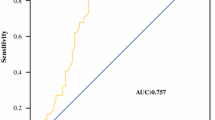Abstract
Object
The histopathological grade of differentiation is one of the significant prognostic factors in pancreatic adenocarcinoma. Especially in the patients with unresectable pancreatic cancer, it is important to obtain the prognostic information non-invasively to avoid unnecessary invasive procedure. The aim of the study was to correlate 18F-fluorodeoxyglucose (FDG) uptake with pathologic grade of pancreatic cancer, furthermore, to evaluate prognostic value of standardized uptake value (SUV).
Methods
FDG-PET scans of 102 patients with histologically proven pancreas adenocarcinoma were retrospectively reviewed. SUV of the primary tumor was calculated for quantification analysis. Pathological differentiation was graded into well-, moderately, and poorly differentiated groups. One-way analysis of variance is performed to test the correlation of the SUV and histopathologic grades. Patients were assigned into 3 categorical groups, using SUV cut-offs of 4 and 7, respectively. Survival functions of different histologic grade and assigned groups according to SUV were estimated by Kaplan–Meier estimator and compared by log-rank test. Multivariate analysis was performed using the Cox proportional hazard regression model.
Results
There was a significant correlation of SUVs and pathologic grades (F = 4.97, p < 0.01). The mean SUV of well-, moderately and poorly differentiated groups was 4.93, 6.47 and 7.29, respectively. Tumor size, AJCC stage and treatment method were significantly related to the degree of FDG uptakes. SUV also shows a significant correlation with survival (p < 0.01), with better prognosis in lower SUV group. In multivariate analysis, the treatment method was the most strongly independent predictor (p < 0.01), followed by age (p = 0.04) and tumor size (p = 0.06). In moderately differentiated group, higher SUV showed significantly worse survival (p = 0.02).
Conclusion
SUV is related with histologic grade and might be competitive predictor for patients’ survival. Specifically, the prognosis of the patients with moderately differentiated pancreas adenocarcinoma could be stratified according to SUV.




Similar content being viewed by others
References
Jemal A, Siegel R, Ward E, Murray T, Xu J, Thun MJ. Cancer statistics, 2007. CA Cancer J Clin. 2007;57:43–66.
Karademir S, Sökmen S, Terzi C, Sağol O, Ozer E, Astarcioğlu H, et al. Tumor angiogenesis as a prognostic predictor in pancreatic cancer. J Hepatobiliary Pancreat Surg. 2000;7:489–95.
Delbeke D, Rose DM, Chapman WC, Pinson CW, Wright JK, Beauchamp RD, et al. Optimal interpretation of FDG PET in the diagnosis, staging and management of pancreatic carcinoma. J Nucl Med. 1999;40:1784–91.
Franke C, Klapdor R, Meyerhoff K, Schauman M. 18-FDG positron emission tomography of the pancreas: diagnostic benefit in the follow-up of pancreatic carcinoma. Anticancer Res. 1999;19:2437–42.
Adsay NV, Basturk O, Cheng JD, Andea AA. Ductal neoplasia of the pancreas: nosologic, clinicopathologic, and biologic aspects. Semin Radiat Oncol. 2005;15:254–64.
Alexander D, Jhala N, Chatla C, Steinhauer J, Funkhouser E, Coffey CS, et al. High-grade tumor differentiation is an indicator of poor prognosis in African Americans with colonic adenocarcinomas. Cancer. 2005;103:2163–70.
Sun Z, Aubry MC, Deschamps C, Marks RS, Okuno SH, Williams BA, et al. Histologic grade is an independent prognostic factor for survival in non-small cell lung cancer: an analysis of 5018 hospital- and 712 population-based cases. J Thorac Cardiovasc Surg. 2006;131:1014–20.
Folpe AL, Lyles RH, Sprouse JT, Conrad EU 3rd, Eary JF. (F-18) fluorodeoxyglucose positron emission tomography as a predictor of pathologic grade and other prognostic variables in bone and soft tissue sarcoma. Clin Cancer Res. 2000;6:1279–87.
Crippa F, Seregni E, Agresti R, Chiesa C, Pascali C, Bogni A, et al. Association between [18F]fluorodeoxyglucose uptake and postoperative histopathology, hormone receptor status, thymidine labelling index and p53 in primary breast cancer: a preliminary observation. Eur J Nucl Med. 1998;25:1429–34.
Okereke IC, Gangadharan SP, Kent MS, Nicotera SP, Shen C, DeCamp MM. Standard uptake value predicts survival in non-small cell lung cancer. Ann Thorac Surg. 2009;88:911–5.
Maemura K, Takao S, Shinchi H, Noma H, Mataki Y, et al. Role of positron emission tomography in decisions on treatment strategies for pancreatic cancer. J Hepatobiliary Pancreat Surg. 2006;13:435–41.
Lee SM, Kim T-S, Lee JW, Kim S-K, Park S-J, et al. Improved prognostic value of standardized uptake value corrected for blood glucose level in pancreatic cancer using F-18 FDG PET. Clin Nucl Med. 2011;36:331–6.
Choi HJ, Kang CM, Lee WJ, Song SY, Cho A, et al. Prognostic value of 18F-fluorodeoxyglucose positron emission tomography in patients with resectable pancreatic cancer. Yonsei Med J. 2013;54:1377–83.
Wakabayashi H, Nishiyama Y, Otani T, Sano T, Yachida S, et al. Role of 18F-fluorodeoxyglucose positron emission tomography imaging in surgery for pancreatic cancer. World J Gastroenterol. 2008;14:64–9.
Kloppel G, Lingenthal G, von Bulow M, Kern HF. Histological and fine structural features of pancreatic ductal adenocarcinomas in relation to growth and prognosis: studies in xenografted tumours and clinico-histopathological correlation in a series of 75 cases. Histopathology. 1985;9:841–56.
Luttges J, Schemm S, Vogel I, Hedderich J, Kremer B, Kloppel G. The grade of pancreatic ductal carcinoma is an independent prognostic factor and is superior to the immunohistochemical assessment of proliferation. J Pathol. 2000;191:154–61.
Tannapfel A, Wittekind C, Hunefeld G. Ductal adenocarcinoma of the pancreas. Histopathological features and prognosis. Int J Pancreatol. 1992;12:145–52.
Acknowledgments
This study was supported by the National Research Foundation of Korea Grant funded by the Korean Government (NRF-2011-013-E00038, NRF No. 2012027276) and National R&D Program for Cancer Control, Ministry of Health and Welfare (1320210).
Author information
Authors and Affiliations
Corresponding author
Rights and permissions
About this article
Cite this article
Ahn, S.J., Park, MS., Lee, J.D. et al. Correlation between 18F-fluorodeoxyglucose positron emission tomography and pathologic differentiation in pancreatic cancer. Ann Nucl Med 28, 430–435 (2014). https://doi.org/10.1007/s12149-014-0833-x
Received:
Accepted:
Published:
Issue Date:
DOI: https://doi.org/10.1007/s12149-014-0833-x




